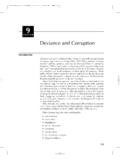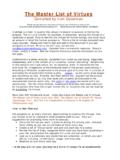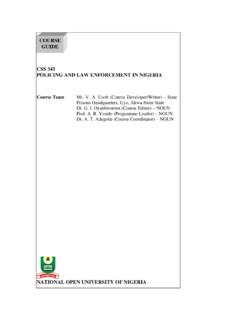Transcription of The Influence of Peer Pressure on Criminal Behaviour
1 IOSR Journal Of Humanities And Social Science (IOSR-JHSS) Volume 21, Issue 1, (Jan. 2016) PP 08-14 e-ISSN: 2279-0837, p-ISSN: 2279-0845. DOI: 8 | Page The Influence of peer Pressure on Criminal Behaviour May Omogho Esiri ( ) Senior LecturerDepartment of Sociology and Psychology, Faculty of the Social Sciences, Delta State University, Abraka, Delta State, Nigeria Abstract: peer Pressure is a reoccurring phenomenon in Criminal or deviant Behaviour especially, as it pertains to adolescents. It may begin in early childhood of about 5years and increase through childhood to become more intense in adolescence years.
2 This paper examines how peer Pressure is present in adolescents and how it may Influence or create the leverage to non-conformity to societal norms and laws. The paper analyses the process and occurrence of peer Influence and Pressure on individuals and groups within the framework of the social learning and the social control theories. Major features of the peer Pressure process are identified as group dynamics, delinquent peer subculture, peer approval of delinquent Behaviour and sanctions for non-conformity which include ridicule, mockery, ostracism and even mayhem or assault in some cases.
3 Also, the paper highlights acceptance and rejection as key concepts that determine the sway or gladiation of adolescents to deviant and Criminal Behaviour . Finally, it concludes that peer Pressure exists for conformity and in delinquent subculture, the result is conformity to Criminal codes and Behaviour . The paper recommends more urgent, serious and offensive grass root approaches by governments and institutions against this growing threat to the continued peace, orderliness and development of society. I. Introduction In every society, there exists groups that are part of the larger society but whose members adhere to norms and values that favour the violation of the norms of the larger society.
4 Hence, Criminal Behaviour often times represents a collective response that is directed by subcultural values and norms of distinct collectivities such as peer groups within the larger group. Individuals in society will usually make friends or have their closest associates from among their peer groups. Therefore, peer associates have a great Influence on the lifestyle of their members. Infact peer group association as an agent of socialization, determines to a large extent, what social codes an individual learns (Sutherland 1949, Allen, 2003, Nsofor, 2013). This implies that individuals whose core group members believe and act Criminal within norms will learn and internalize more of Criminal codes than those that conform with the norms of the society.
5 As a result, they conclude that individuals become delinquent through association with people who are the carriers of Criminal norms and that Criminal Behaviour is learned within primary groups in particular, peer groups. That is, Criminal Behaviour in adolescents is as a result of social Influence . It is important to note here, that primary groups are the smallest units of interactions in society and a small group within the society is more likely to have a stronger control over an individual s action or Behaviour . Infact, Simmel (1971), observed that a small group is likely to control the individual completely.
6 Again, Behaviour that is deviant or Criminal (that is Behaviour that violates the norms of a society and is punished) is relative to different social contexts. Societies especially modern ones, consists of various groups with different subcultures. Hence, Behaviour that conforms to one particular subculture, maybe considered or viewed deviant outside of it. For example, there might be a strong Pressure on a member of a university cult group to prove himself by raping a girl or even killing a student. So also there may be Pressure on someone in a position of affluence among the peer clique to engage in embezzling and tax evasion or to take or give bribe so as to be approved of or accepted.
7 peer groups or associations have their own cultures, sanctions or rituals into which members are socialized and accordingly, members (especially new members) who do not comply with any of these may be ostracised (Carlson, 2010). peer Pressure extends to all groups. A peer group refers to persons that belong to the same age (or about the same age) and/or status. Examples of peer groups include, age peer group, school or educational peer group, social peer group, professional peer group and work peer group. II. Criminal Behaviour Behaviour that does not conform to the cultural norms or laws of a given society at a particular time and is often times negatively sanctioned, is referred to as Criminal .
8 This implies that non-conformity to a given set of laws or norms that are accepted by a significant number of people in a community, society or group is a Criminal act. Society highly values conformity and expects it to be accepted and upheld by its members. The Influence Of peer Pressure On Criminal Behaviour DOI: 9 | Page Accordingly, society has put in place processes and institutions that will ensure and establish the necessary peace, order and stability required for the progress and development of humanity and society.
9 Socialization is one of such processes which is carried out by espicially the family, the school and religious bodies. Aside from these institutions, other informal primary groups involved in the socialization of individuals are the neigbourhood and peer group or friendship clique. Through the socialization process, it is intended that the cultural norms and values of society which spell out the approved and disapproved (right and wrong) Behaviour of society is taught to its members. However, as a result of other mitigating factors in society as well as individual differences, the outright or subtle violation of societal laws (crime) and Criminal tendencies remain a feature of every society.
10 (Durkheim, 1966, Igbinovia, 2003 and Dambazzu, 2011). They argue that crime is inevitable in all societies. Igbinovia (2003) observed that there is hardly any Nigerian living today that can claim that he or she has not advertently or inadvertently, by commission or omission been involved in crimes or benefitted directly or indirectly from criminality or deviance or the commission of crimes or the proceeds of criminality . Apart from individual deviance, non-conformity or deviation from societal norms also occurs as a group. In line with this, Iyoha, 1997, Carlson, 2010 and Esiri and Ejechi, 2013, noted that a greater part of group deviation occurs within society s Criminal subculture.














